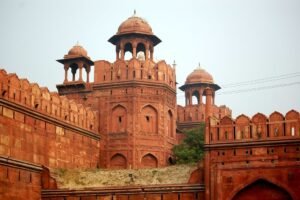Introduction
Nestled in the heart of Delhi, Humayun’s Tomb stands as an exquisite testament to the grandeur of Mughal architecture. This magnificent mausoleum, commissioned by the grieving widow of the second Mughal emperor, Humayun, is a harmonious blend of Persian and Indian architectural styles. Let’s embark on a journey through time to explore the rich history, architectural brilliance, and cultural significance of this timeless marvel.
Table of Contents
Historical Background
Construction and Commissioning
Humayun’s Tomb was commissioned by Empress Bega Begum, also known as Haji Begum, in 1569, nine years after the death of her husband, Emperor Humayun. The construction was supervised by the Persian architect Mirak Mirza Ghiyas and his son Sayyid Muhammad. The tomb was completed in 1572, marking a significant era in Mughal architecture.
Architectural Influences
The architectural influences of Humayun’s Tomb are deeply rooted in Persian and Central Asian styles. The use of red sandstone and white marble, intricate geometric patterns, and the incorporation of Persian-style chahar bagh (four-fold garden) reflect the prevailing aesthetic tastes of the time.
Architectural Marvels
Garden Layout
The tomb is surrounded by a large Persian-style garden divided into four quadrants by water channels—a classic chahar bagh. The meticulously planned garden is adorned with pathways, water features, and lush greenery, creating a serene ambiance.
Main Mausoleum
The main mausoleum is an imposing structure constructed with red sandstone and crowned with a pristine white marble dome. The symmetrical facades, intricate carvings, and calligraphic inscriptions from the Quran showcase the architectural finesse of the Mughals.
Char Bagh and Water Features
The garden’s symmetrical layout, inspired by the paradise gardens of Persian tradition, symbolizes the four rivers of paradise. Fountains and water channels intricately align with the axial paths, creating a sense of harmony and providing a peaceful retreat.
Cultural Significance
UNESCO World Heritage Site
In 1993, Humayun’s Tomb was recognized as a UNESCO World Heritage Site. The inscription acknowledged its significance as a masterpiece that influenced Mughal tomb design.
Inspiration for the Taj Mahal
Humayun’s Tomb is often considered a precursor to the Taj Mahal, inspiring subsequent Mughal architecture, notably the iconic marble mausoleum commissioned by Emperor Shah Jahan for his beloved wife Mumtaz Mahal.
Visitor Information
Location and Accessibility
Humayun’s Tomb is located in Nizamuddin East, Delhi, easily accessible by road. The nearest metro station is the Jawaharlal Nehru Stadium Metro Station. The tomb complex is open to visitors throughout the week.
Best Time to Visit
The best time to visit Humayun’s Tomb is during the winter months (October to March) when the weather is pleasant, making the exploration of the gardens more enjoyable.
Nearby Attractions
Explore the historical richness of the surrounding area, which includes the historic Nizamuddin Dargah, Isa Khan’s Tomb, and the beautiful Sunder Nursery.
Conclusion
Humayun’s Tomb stands as a living testament to the artistic and architectural brilliance of the Mughal era. Its cultural significance, historical importance, and enduring beauty make it a must-visit destination for anyone exploring the heritage of Delhi. As you wander through the geometrically laid gardens and marvel at the intricacies of the mausoleum, you’ll undoubtedly feel a profound connection to the rich history that unfolds within its walls.
FAQs
1. What is Humayun’s Tomb?
- Humayun’s Tomb is a magnificent historical monument in Delhi, India. It is the tomb of the Mughal Emperor Humayun.
2. When was Humayun’s Tomb built?
- The construction of Humayun’s Tomb began in 1565 and was completed in 1572.
3. Who commissioned the construction of Humayun’s Tomb?
- The tomb was commissioned by Humayun’s widow, Empress Bega Begum.
4. What is the architectural style of Humayun’s Tomb?
- Humayun’s Tomb is a classic example of Mughal architecture and is considered a precursor to the Taj Mahal.
5. Is Humayun’s Tomb a UNESCO World Heritage Site?
- Yes, Humayun’s Tomb is a UNESCO World Heritage Site since 1993.
6. Can visitors enter the tomb?
- Yes, visitors can enter the main chamber of the tomb. The site is open to the public.
7. What are the notable features of Humayun’s Tomb?
- Notable features include the charbagh (fourfold garden), water channels, and the prominent use of red sandstone and white marble in construction.
8. What is the significance of Humayun’s Tomb?
- Besides being a tomb, it holds historical and architectural significance as a masterpiece of Mughal architecture.
9. Are there any other structures around Humayun’s Tomb?
- Yes, there are other smaller tombs and structures within the complex, contributing to its overall grandeur.
10. Is there an entry fee for Humayun’s Tomb? – Yes, there is an entry fee for visitors. The fee may vary for Indian and foreign tourists.
11. What is the best time to visit Humayun’s Tomb? – The best time to visit is during the winter months (October to March) when the weather is pleasant.
12. Are there any restrictions for photography? – While photography is generally allowed, there might be specific restrictions, especially in the main tomb chamber.
13. Can I hire a guide at Humayun’s Tomb? – Yes, there are usually guides available at the entrance who can provide detailed information about the history and architecture.
14. How long does it take to explore Humayun’s Tomb? – The time required can vary, but a comprehensive visit might take around 1 to 2 hours.
15. Are there any nearby attractions to visit after Humayun’s Tomb? – Yes, several other historical sites like India Gate and the Lotus Temple are in close proximity.




